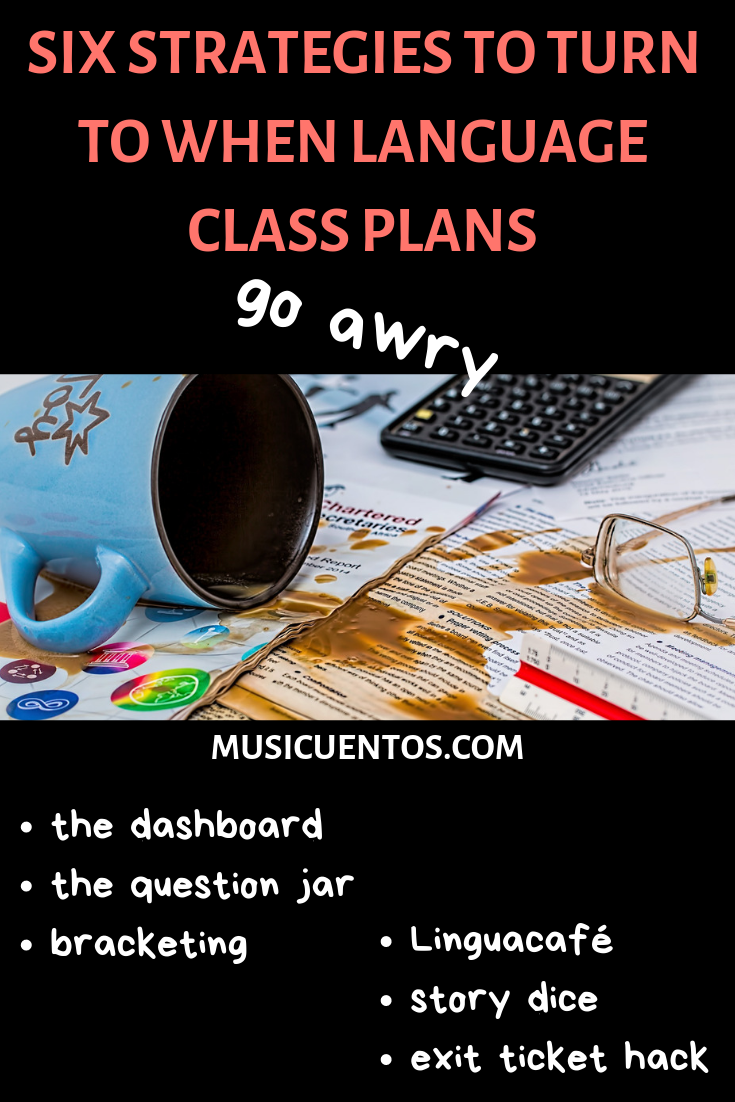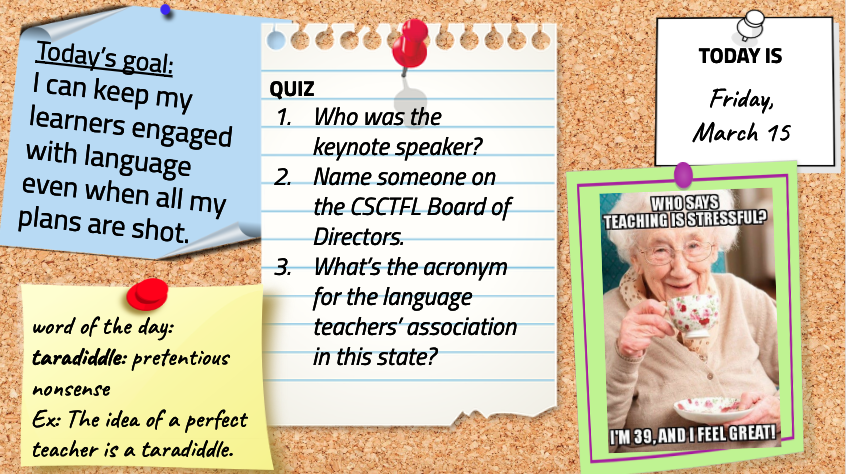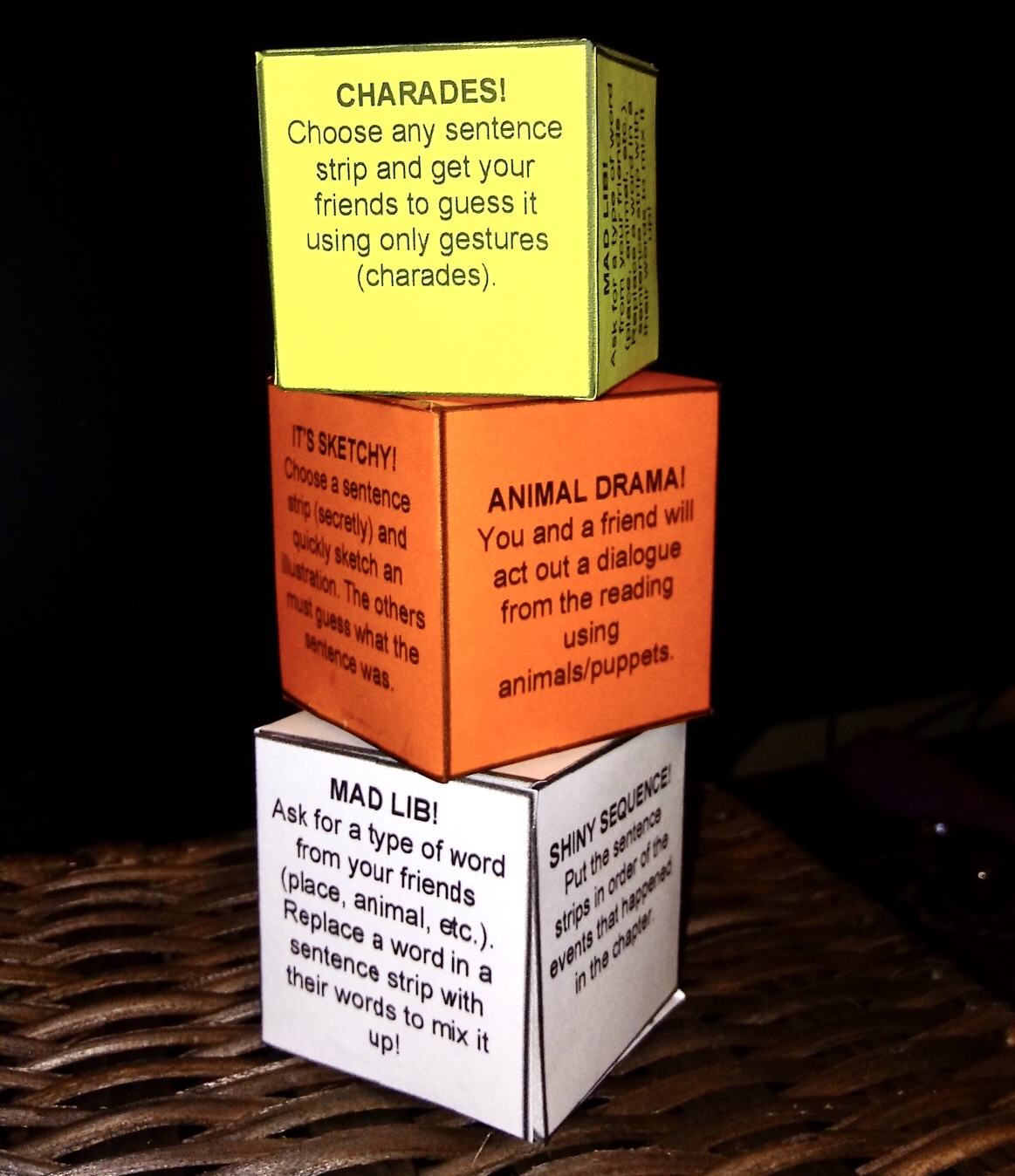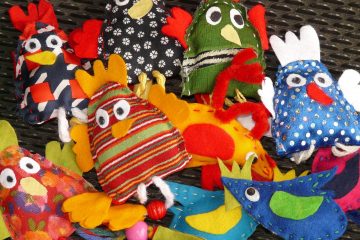Athletic events. Widespread illness. Someone’s unprepared (teacher or students) or arrived late (“Teachers, due to a car accident on the highway, do not count any student tardy in first period today”). Emergency drill – or a passing kindergartener decided to pull the fun red handle on the wall. Half the class gone for an AP exam, or early release after the awards assembly, or a student council presentation. Or, it’s 2019 after all, the worst case scenario: the internet is down (projector bulb blew, computer screen went black, or other nightmare tech fail).
Let’s face it, disruptions happen. Some weeks it feels like they’re waiting around every corner. Can we build a repertoire of strategies to engage learners with language even when Pandora’s Box opens and throws everything it’s got at us? Let’s go.

1. The Dashboard
All the credit for this idea goes to Val over at Adventurous Educators. This idea has been a critical way for me to get my learners involved with the day’s goals and language at the very beginning. Remember how I only see my students once a week? Well, I also have to set up and take down my classroom every.single.time. I’ve gleaned ideas from the Twitter PLN for several workarounds, including shower-curtain word walls, but between way too many plates to spin and getting kids to school and hanging up those shower curtains, I’m rarely ready to go right on the hour. But as long as I’ve got the dashboard up, they can get started. Consider it a fun replacement for a bell ringer, if you will.

My dashboard includes:
- The day and date
- Today’s goal (a Can Do statement in English)
- The Word of the Day with an example sentence (from today’s content)
- A quiz or other “get started” interactive piece
- A meme or comic using the current topic or word of the day
Don’t make one yourself – just save a copy of mine and tweak away.
2. The Question Jar
I have a jar of questions my learners can ask each other. You can have a separate jar for separate levels, or you can color-code the questions by low novice (“What’s your name?”), high novice (“What do you do for fun?”), or intermediate (“Describe what you like to do on Saturdays.”) Extra props if you decorate the jar. Check out my Spanish questions and/or make your own, toss them in a jar, add new ones as your learners’ proficiency grows, and set out the Question Jar when disruptions make your plans go awry.
3. Bracketing
This idea came to me from Elisabeth over at Spanish Mama. I wrote about it recently in my lightning review post, so I won’t spend too much time on it here. It’s a fantastic, zero-prep, input-focused strategy to turn to. This is the one I’d go to first if there are exactly 4 out of 27 students present in my first period because of a highway traffic jam.
Basically, use whatever topic is current or interesting in your class- food, clothes, activities, vacation spots, anything. Come up with either 8 or 16 options in the TL with this theme. (Don’t do brand names or cognates unless you have no-measurable-proficiency novices – that’s a waste of this great input!) Bracket them on the board the way you would with World Cup or March Madness teams. Then, ask learners to vote them forward until you have a winner.
We did this in my session with the 8 possible class disruptions at the beginning of this post. Most common disruptions? It was a tie between tech fail and… who remembers the other one? The important thing is it was fun input!
4. Linguacafé
I can’t tout this idea from Nadine Jacobsen-McLean enough. Don’t miss my post on how this idea rocked my interpersonal world. Basically, in my version, you build a repertoire of slides that prompt conversations related to the current topic/unit/chapter. If you just keep adding conversation slides to your current file, you can go back at any time and use previous questions when there are only 7 minutes left of class because someone pulled the fire alarm.
One of the key pieces of this conversation activity is that the questions and options for answers are up on the slide. This is a completely learner-focused output activity, but students shouldn’t have to create with language if they’re not ready. Learners who are stuck can use any of the answer options on my slide, but I always have many that are ready to try something new and add their own answers. It’s a fantastic differentiated speaking activity. Check out my slides, make a copy, and make them your own.
5. Story Dice
 A lot of blog posts come our way via email and social media, right? Every so often, one offers me such a gem of an idea that I file it in my “resources” folder and bookmark it and then use it… over and over and over. That’s what happened with Elisabeth’s post about bracketing above, and that’s what happened when Elizabeth Dentlinger blogged about reading comprehension with dice. In the last three years I have used this one idea perhaps more than any other one that came my way in recent years. I purple puffy heart my Story Dice. You know I do if it can get this almost-40-year-old woman to use a phrase like “purple puffy heart.”
A lot of blog posts come our way via email and social media, right? Every so often, one offers me such a gem of an idea that I file it in my “resources” folder and bookmark it and then use it… over and over and over. That’s what happened with Elisabeth’s post about bracketing above, and that’s what happened when Elizabeth Dentlinger blogged about reading comprehension with dice. In the last three years I have used this one idea perhaps more than any other one that came my way in recent years. I purple puffy heart my Story Dice. You know I do if it can get this almost-40-year-old woman to use a phrase like “purple puffy heart.”
This requires some up front prep and keeping a kit around, but it’s so worth it. For my activities, I need a mini whiteboard with markers or dry erase crayons (they exist!) and finger puppets or stick puppets. If we’re not using a book chapter or some other story, I also need to include/write the story that is the basis for the activity, and then I need summary strips for the book chapter or story. For example, check out my strips for some of Peter va a Colombia or for all chapters of Tumba.
Feel free to use my dice, check out Elizabeth’s, or make a copy and make it your own.
6. Exit Ticket Hack
This is a simple one to turn to if you’ve filled the class period and haven’t done your exit ticket, but you still want to. I’ve always got a stack of sticky notes around, and I’ll ask kids to grab a sticky note and, for example,
- finish the sentence “I want a million dollars because…”.
- draw and label your favorite of today’s new animal words.
- ask someone near you how they are doing and write their answer on the note.
Here’s my exit ticket hack for you – which of these do you think will make the biggest difference in how you’re able to engage learners when plans go awry? Do you have another idea?
4 Comments
Comments are closed.




Hey, Sara E! Thanks for the mention 🙂
Thank YOU for the great idea!
I LOVE, LOVE, LOVE your DASHBOARD! Thanks for such a wonderful idea! Keep them coming please!
Sra. Galán
MS Spanish Teacher
Thanks – most of the credit goes to Val for this one!